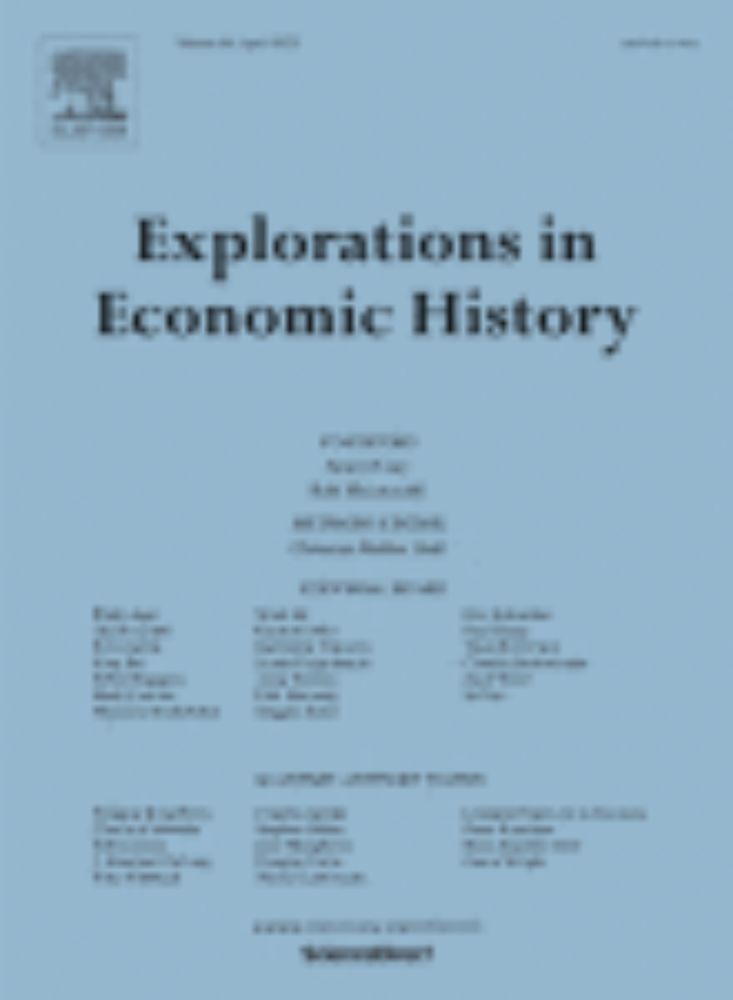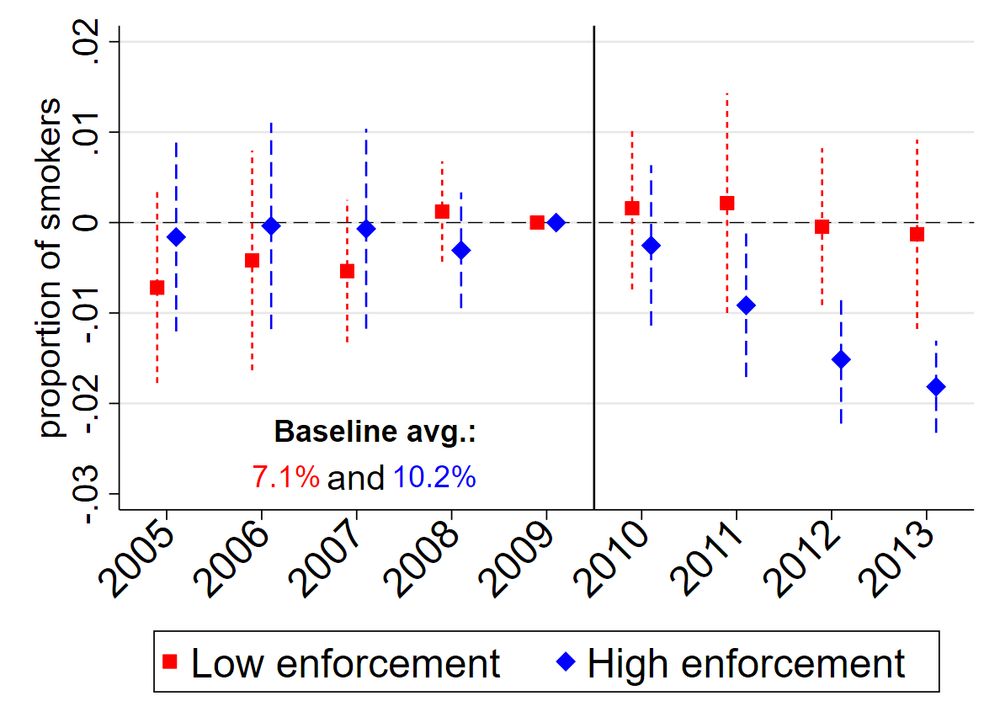
Civil rights protests and election outcomes: Exploring the effects of the poor people’s campaign
The Poor People’s Campaign (PPC) of 1968 was focused on highlighting, and ultimately reducing, poverty in the United States. As part of the campaign, …
New paper out: www.sciencedirect.com/science/arti.... We study (using DiD) effects of 1968 Poor People's Campaign on election outcomes. Overall these peaceful protests had no effects on elections (contrasting prior civil rights era findings) but they hurt Ds in the South and helped them in the West.
24.04.2025 15:09 — 👍 10 🔁 5 💬 0 📌 0
Bottom line:
🚭 Our findings suggest comprehensive, well-enforced bans are an effective tool in shaping smoking behavior.
🧵 8/8
#PublicHealth #TobaccoControl #Brazil #SmokeFree #Economics #Policy #Research
@zew.de @uspoficial.bsky.social @economiausp.bsky.social
14.04.2025 11:42 — 👍 2 🔁 0 💬 0 📌 0
🌎What does this mean beyond Brazil?
➡️ Anti-smoking policies face unique challenges and remain underexplored in developing countries.
➡️ Many European countries still allow smoking lounges or exclude outdoor/partial spaces from bans.
🧵 7/8
14.04.2025 11:42 — 👍 0 🔁 0 💬 1 📌 0

Figure derived from Table 4 of our study. The reduction in prevalence is 2.2 percentage points, representing an 18% decrease from the baseline prevalence of 12%.
Why young adults? Initiation and early-stage addiction are crucial windows for policy impact.
✅ Increased quitting rates — especially among recent starters
✅ Lower initiation
➡️ We also show how to decompose prevalence outcomes and study pre-trends in these settings.
🧵 6/8
14.04.2025 11:42 — 👍 0 🔁 0 💬 1 📌 0

Fig. 3 (d). Impacts of smoking bans on smoking prevalence.
Importantly, enforcement is key ❗
Where enforcement was weak, the policy had no significant impact.
➡️A clear message for policymakers: laws on paper are not enough!
🧵 5/8
14.04.2025 11:42 — 👍 0 🔁 0 💬 1 📌 0
Our key finding:
🚭 In places with strong enforcement, the bans led to an 18% reduction in smoking prevalence among young adults within 4 years!
🧵 4/8
14.04.2025 11:42 — 👍 0 🔁 0 💬 1 📌 0
Between 2009–2013, several Brazilian states and state capitals implemented strict bans covering all enclosed/partially enclosed public spaces.
➡️ No smoking lounges
➡️ Enforced compliance
🧵 3/8
14.04.2025 11:42 — 👍 0 🔁 0 💬 1 📌 0
Brazil is a global success story in tobacco control.
📉From 18% in 2008 to 12.6% in 2019, smoking prevalence has steadily declined.
But have smoke-free policies contributed to this? We investigated. 👇
🧵 2/8
14.04.2025 11:42 — 👍 0 🔁 0 💬 1 📌 0
Redirecting
🚭 Publication alert!
Are smoking bans effective in shaping smoking behavior?
New paper w/ @paulapereda.bsky.social in the Journal of Development Economics explores Brazil’s experience with smoke-free policies, uncovering key mechanisms.
doi.org/10.1016/j.jd...
#Econsky #PublicHealth #Brazil
🧵 1/8
14.04.2025 11:42 — 👍 4 🔁 2 💬 1 📌 0
Bottom line:
🚭 Our findings suggest comprehensive, well-enforced bans are an effective tool in shaping smoking behavior.
🧵 8/8
#Econsky #PublicHealth #TobaccoControl #Brazil #SmokeFree #Economics #Policy #Research
@zew.de @uspoficial.bsky.social @economiausp.bsky.social
14.04.2025 11:30 — 👍 1 🔁 0 💬 0 📌 0

Figure derived from Table 4 of our study. The reduction in prevalence is 2.2 percentage points, representing an 18% decrease from the baseline prevalence of 12%.
Why young adults? Initiation and early-stage addiction are crucial windows for policy impact.
✅ Increased quitting rates — especially among recent starters
✅ Lower initiation
➡️ We also show how to decompose prevalence outcomes and study pre-trends in these settings.
🧵 6/8
14.04.2025 11:30 — 👍 3 🔁 0 💬 0 📌 0

Fig. 3(d). Impacts of smoking bans on smoking prevalence.
Importantly, enforcement is key ❗
Where enforcement was weak, the policy had no significant impact.
A clear message for policymakers: laws on paper are not enough!
🧵 5/8
14.04.2025 11:30 — 👍 0 🔁 0 💬 1 📌 0
Our key finding:
🚭 In places with strong enforcement, the bans led to an 18% reduction in smoking prevalence among young adults within 4 years!
🧵 4/8
14.04.2025 11:30 — 👍 0 🔁 0 💬 1 📌 0
Between 2009–2013, several Brazilian states and state capitals implemented strict bans covering all enclosed/partially enclosed public spaces.
➡️ No smoking lounges
➡️ Enforced compliance
🧵 3/8
14.04.2025 11:30 — 👍 0 🔁 0 💬 1 📌 0
Brazil is a global success story in tobacco control.
📉 From 18% in 2008 to 12.6% in 2019, smoking prevalence has steadily declined.
But have smoke-free policies contributed to this? We investigated. 👇
🧵 2/8
14.04.2025 11:30 — 👍 0 🔁 0 💬 1 📌 0
Economic historian @UoGuelph w broad social science & historical interests: population health, First Nations demography, mobility, inequality & lives of the incarcerated 🇨🇦🇦🇺🇳🇿🏴
Editing Asia-Pacific Econ History Rev & directing https://thecanadianpeoples.com.
I play with data @EmoryEconomics. Interested in family, education, health, child development, labor, crime, and environment. Uppsala University alumnus. I hang out in Pacific Northwest a lot thus ⛷️ and 🚵 posts too
https://sites.google.com/site/kkarbownik
Economist and Professor at FEA-USP. Research interests: environment, health and gender issues. Website: https://sites.google.com/site/paulapereda/home
Assistant Professor at Sao Paulo Schools of Economics (FGV). Ph.D. 2022 at Yale. Passionate about Econometrics, especially Causal Inference. (He/his)
https://sites.google.com/site/vitorapossebom/
Assistant Professor @ifo_Institut/LMU (Applied Micro/Labor)
https://sites.google.com/view/cacilialipowski/about-me
Doctoral Research Fellow in Economics @unikonstanz.bsky.social @excinequality.bsky.social & Researcher at ZEW Mannheim | Life enthusiast & big fan of asking 'why' questions
For more information on my research, visit: sites.google.com/view/oliverschlenker
Post-Doc at IAB, interested in applied micro/labor econ, tech change, skill shortages and migration - research in general 💡
https://sites.google.com/view/boris-s-ivanov/
Economist writing about the labor market on https://recruitonomics.com/ and #rstats fan
Labor economist @ Carnegie Mellon University. Fan of rail ferries, portage railways, transporter bridges, and funiculars.
Professor, Durham Law School. Effective labour regulation/decent work. Co-founder and Organizing Committee, Regulating for Decent Work Conference. Editorial Committee, Industrial Law Journal. Former Official @ILO.
Labour Studies Professor at Brock University | Teach & research collective bargaining, unions & labour politics |
brocku.ca/lsavage
Labor economist at Cemfi
https://sites.google.com/view/samuel-bentolila-home
Econ prof University of Zurich.
Faculty affiliate at JPAL, CEPR, CESifo.
Board member IIPF, Helvetas, GAIN.
#EconSky
Assistant Professor of Economics at the University of Mannheim. PhD from UCSD Econ. Macroeconomics, Growth and Development, Human Capital.
http://minkikim-econ.com
Econ Assistant Prof at Sheffield | IZA Research Fellow | Visiting Fellow at LSE and UCL | Parenting, child development, gender, education, social mobility | From Genoa, living in London | First Gen in HE | Mum of 2 | https://gretamorando.weebly.com/
News and analysis with a global perspective. We’re here to help you understand the world around you. Subscribe here: https://econ.st/4fAeu4q
Founded in 1983 as the first journal devoted specifically to labor economics.
The Quarterly Journal of Economics is the oldest professional journal of Economics in the English language. Edited by the Department of Economics at Harvard.
Economics Professor at Brown, studying discrimination, education, healthcare, and applied econometrics. I like IV
https://sites.google.com/site/aboutpeterhull/home
One of the oldest and most prestigious journals in economics, the Journal of Political Economy presents significant and essential scholarship in economic theory and practice. https://www.journals.uchicago.edu/journals/jpe/about


